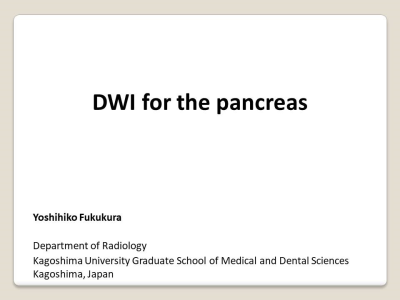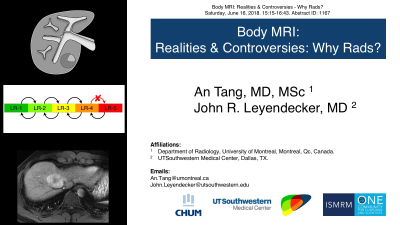|
Weekend Educational Course
Body MRI: Realities & Controversies |
|
Body MRI: Realities & Controversies: Other GI Imaging
Weekend Course
ORGANIZERS: Kathryn Fowler, Kartik Jhaveri, Lorenzo Mannelli, Valeria Panebianco, Scott Reeder, Reiko Woodhams
Saturday, 16 June 2018
| S02 |
13:15 - 14:45 |
Moderators: Jeffrey Brown, Naranamangalam Jagannathan |
Skill Level: Intermediate
Session Number: WE-03C
Overview
This whole-day course provides an overview of current issues in MRI practice (safety, contrast, state-of-the-art imaging), areas for possible expansion, and educational sessions covering liver, pancreaticobiliary, and GI MRI. The final portion of the session attempts to provide a balanced view of new standardized lexicons that are used in MRI (BI-RADS, LI-RADS, PI-RADS).
Target Audience
This course is aimed at radiologists, imaging scientists and MR technologists who wish to review the state-of-art MRI protocols and indications for assessment of disease in the abdomen and pelvis.
Educational Objectives
As a result of attending this course, participants should be able to:
-Summarize new state-of-the-art equipment, sequences, and contrast agents used in Body MRI;
-Review areas of possible clincal practice expansion: thoracic MRI, emergency indications, and whole body imaging;
-Demonstrate the impact of MRI in diagnostic workup of liver and gastrointestinal disease processes; and
-Illustrate the role of standardized lexicon systems through a point and counterpoint approach.
13:15
|
 |
 DWI for the Pancreas DWI for the Pancreas
Yashihiko Fukukara
DWI reflects changes in water mobility caused by interactions with cell membranes, macromolecules, and alterations to the tissue environment. It enables quantitative assessment of tissue diffusivity based on the apparent diffusion coefficient. Advances in image quality have made DWI a routinely implemented clinical protocol for the pancreas, as it can be performed relatively quickly and has excellent contrast resolution without the administration of contrast agents. DWI is a promising technique for the evaluation of pancreas tumors, including detection, characterization, monitoring treatment response, and prediction of patient prognosis. Its role in the above mentioned clinical settings will be discussed.
|
13:37
|
|
 MR Enterography MR Enterography
Jordi Rimola
In this lecture we are going to discuss the key signs for detecting and grading active inflammation and characterizing complications, in particular strictures. We also highlight the current limitations of the technique and potential ways to overcome them.
|
13:59
|
|
 MRI of Perianal Fistula MRI of Perianal Fistula
Ellie Korngold
|
14:21
|
|
 Advances in Abdominal Imaging Advances in Abdominal Imaging
Shreyas Vasanawala
|
14:45
|
|
Break & Meet the Teachers |
|
| |
|
Body MRI: Realities & Controversies: Why Rads?
Weekend Course
ORGANIZERS: Kathryn Fowler, Kartik Jhaveri, Lorenzo Mannelli, Valeria Panebianco, Scott Reeder, Reiko Woodhams
Saturday, 16 June 2018
| S02 |
15:15 - 16:45 |
Moderators: Kathryn Fowler, Elizabeth Hecht |
Skill Level: Intermediate
Session Number: WE-03D
Overview
This whole-day course provides an overview of current issues in MRI practice (safety, contrast, state-of-the-art imaging), areas for possible expansion, and educational sessions covering liver, pancreaticobiliary, and GI MRI. The final portion of the session attempts to provide a balanced view of new standardized lexicons that are used in MRI (BI-RADS, LI-RADS, PI-RADS).
Target Audience
This course is aimed at radiologists, imaging scientists and MR technologists who wish to review the state-of-art MRI protocols and indications for assessment of disease in the abdomen and pelvis.
Educational Objectives
As a result of attending this course, participants should be able to:
-Summarize new state-of-the-art equipment, sequences, and contrast agents used in Body MRI;
-Review areas of possible clinical practice expansion: thoracic MRI, emergency indications, and whole-body imaging;
-Demonstrate the impact of MRI in diagnostic workup of liver and gastrointestinal disease processes; and
-Illustrate the role of standardized lexicon systems through a point-and-counterpoint approach.
15:15
|
 |
 LI-RADS: Pro LI-RADS: Pro
An Tang
The Liver Imaging Reporting And Data System (LI-RADS) was developed to standardize the interpretation, reporting and data collection for imaging examinations in patients at risk for hepatocellular carcinoma (HCC). The system has been developed by committees composed of radiologists, hepatologists, pathologists, and surgeons. In this debate, we will discuss the reasons why LI-RADS is needed and the problems that it solves. In response to current limitations of LI-RADS, we will discuss strategies to address unmet needs and to refine the system in response to new scientific evidence and user feedback.
|
15:37
|
 |
 LI-RADS: Con LI-RADS: Con
John Leyendecker
LI-RADS is an important advance in standardization of HCC imaging and reporting. However, there are still many deficiencies that must be addressed for widespread implementation to succeed. This talk will highlight the concerns of LI-RADS users and the potential ways these concerns can be addressed in the future.
|
15:59
|
 |
 PI-RADS: Pro PI-RADS: Pro
Francois Cornud, David EISS, Arnaud Lefevre
The PI-RADS scoring system consists in a visual assessment to detect the presence of suspicious foci within the prostate. It has also been developped to describe signs of tumor extraprostatic extension. Diffusion Weighted Imaging (DWI) plays an unvaluable role to achieve this goal. Very high computed b-values allow to visually increase the conspicuity of tumor foci within the peripheral zone (PZ). DWI has also an important role to increase the sensitivity of T2W-MRI to localise tumor foci originating in the transition zone (TZ), without affecting the specificity. Dynamic Contrast Enhanced MRI plays a role to confirm the presence of a tumor in specific areas, like the Anterior FibroMuscular Stroma or to detect signs of seminal vesicle invasion, which may remain undetected by DWI alone.
|
16:21
|
|
 PI-RADS - Con PI-RADS - Con
Alberto Vargas
This talk will emphasize the weaknesses of the Prostate Imaging Reporting and Data system, highlight areas of potential improvement, and discuss ways of dealing with commonly encountered limitations of the guideline in "real-life" scenarios
|
16:43
|
|
 MRI Diffuse Liver Disease MRI Diffuse Liver Disease
Shahid Hussain
|
| 17:00 |
|
SAMs: MRI Diffuse Liver Disease
|
17:05
|
|
Adjournment & Meet the Teachers |
|
| Back |
| The International Society for Magnetic Resonance in Medicine is accredited by the Accreditation Council for Continuing Medical Education to provide continuing medical education for physicians. |





